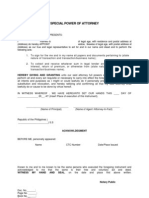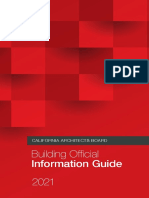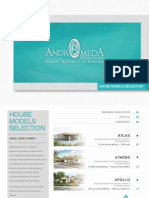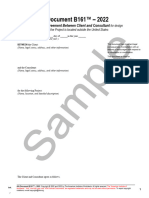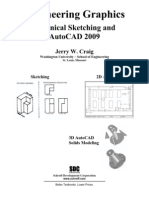4 +Client-Architect+Relationship
4 +Client-Architect+Relationship
Uploaded by
Supriya BhutaniCopyright:
Available Formats
4 +Client-Architect+Relationship
4 +Client-Architect+Relationship
Uploaded by
Supriya BhutaniOriginal Description:
Original Title
Copyright
Available Formats
Share this document
Did you find this document useful?
Is this content inappropriate?
Copyright:
Available Formats
4 +Client-Architect+Relationship
4 +Client-Architect+Relationship
Uploaded by
Supriya BhutaniCopyright:
Available Formats
THE CLIENT/ARCHITECT RELATIONSHIP
As professionals we have a responsibility to educate our clients about the architect's role and
responsibility in the design and construction process. Cultivating an environment of education
fosters trust, enhances communication, minimizes unnecessary frustration, and builds
successful business relationships with our clients.
A good working relationship between architect and client is crucial to the success of any project.
When working well with an architect, the savings are there from the start in terms of time and
money.
Architects Role
While written agreements may contain the most important pieces of information about a
construction project, the process of deciding what will be in those agreements begins well
before they are finally drafted and signed. It is important for us to educate our clients in
understanding the architect's roles and responsibilities on a typical project.
It is important that our clients understand early that an architect is a professional advisor.
Lawyers and doctors do not guarantee the results of their performance, and neither do
architects. Educating our client about the scope and limit of the architect's role and responsibility
may help minimize erroneous assumptions and expectations.
Clients Role
Architects can sometimes assume that clients have a broader understanding of the building
design and construction process and of the parties' roles and responsibilities in that process
than they really do. This can lead to frustration and misunderstanding when the client does not
perform the role that the architect expects. We will endeavor to help our clients to fully
understand the terms of the client-architect agreement, the owner-contractor agreement, and
the general conditions of the contract for construction. While a lack of knowledge does not
relieve the client of contractual obligations, it may lead to unnecessary misunderstandings,
conflicts, and legal disputes.
Laying the Foundation for Success
We wish to establish an environment in which educating the client about the role of architects,
building design and construction is routine. This helps both the architect and the client to
understand the process from a common vantage point. The time and energy invested is likely to
be less than that required to resolve disputes later and may have the added benefit of fostering
a long-term relationship of trust.
ARCHITECTURE INTERIOR DESIGN PLANNING
905-331-4480 Page 1 of 4 cz@czarchitect.com
CYNTHIA ZAHORUK ARCHITECT Inc.
The following checklist, while not intended to be exhaustive, may serve as a starting point for
discussion and to broaden our client's knowledge.
Architects provide services, not products. Those services are focused on meeting the
expressed needs of a client.
An architect is a client's consultant whose role is to provide design services and assist
the client in securing from the contractor a project that is in general conformity with the
architect's design concept and specifications.
Contractors, not architects, are responsible for building the project. Architects assume
responsibility for issues under their control, within reason. For example, architects do
not control activity on the construction site and cannot be held responsible for job site
safety or scheduling.
Construction documents are not intended to thoroughly depict every element of the
design; it would be cost-prohibitive to do so. Therefore, a reasonable number of
questions from the contractor should be expected.
It is not possible to anticipate every possible circumstance or physical condition that may
arise during construction. Change orders are likely to occur on any project. Clients
should anticipate changes by including adequate contingencies in the construction
budget to cover the cost of the changes.
Changes to the project program or design may require the architect to expend additional
time, for which the architect is fairly entitled to additional compensation.
Architects produce only approximate cost estimates-not fixed, unchanging, or
guaranteed cost estimates. Architects have no control over, or special knowledge of the
costs of materials, labour, fuel and equipment.
Architects do not manufacture or install the project components they specify, nor can
they guarantee those components.
Construction phase observation services are intended to determine general conformity
of the construction with the plans and specifications. Certifications are not intended to
detect every minor deficiency.
The architect and the client must share a mutual understanding of the client's goal for
the project, the professional services being provided and the client's expectations of the
architect.
An architect's performance is measured against the professional standard of care, not an
arbitrary idea of perfection.
ALIGNING EXPECTATIONS
We want to take the opportunity to align architectural design and client expectations and to give
the project team some options for managing the risks, and to define how we, as designers, can
meet or exceed those expectations in order to have a satisfied client and a successful project
outcome.
ARCHITECTURE INTERIOR DESIGN PLANNING
905-331-4480 Page 2of 4 cz@czarchitect.com
CYNTHIA ZAHORUK ARCHITECT Inc.
The Standard of Care
Designing a new or renovated building can be a challenging undertaking. Despite the best
efforts of the design team, mistakes will occur. No architect or engineer in the business can
guarantee perfection. If they did, no insurance policy would back it.
Practicing architects and engineers provide a professional service based on years of education
and experience. By entering into a contract with our clients, we imply that we possess the
"standard skill and ability" necessary to serve the owner's needs. Nevertheless, there is no
guarantee of a perfect plan or even satisfactory results. Instead, architects and engineers are
expected to use "reasonable and ordinary care" in the practice of their profession.
In managing the design and construction efforts of any project, one of the most common
challenges we face is coaching our clients is on realistic expectations for design documents and
construction. A good starting point is to draw comparisons to other professions that apply a
"standard of care." For more than a century, the law has viewed architectural and engineering
services similar to professional services provided by physicians and attorneys.
Some clients have a tendency is to view architectural and engineering services no differently
than lawn care services that guarantee weed-free results. This is especially true in this age of
consumer rights and protections, where "satisfaction guaranteed" rules the day.
It is generally accepted that a surgeon cannot guarantee a perfect procedure or a complete
recovery, and an attorney cannot guarantee a favorable judgment or verdict. Instead, the
expectation is that they will apply their professional knowledge and experience in a competent
manner that best serves the interest of their patients or clients, regardless of the ultimate
outcome. Architects and engineers, like physicians and attorneys, cannot guarantee the results
of their service.
Errors and Omissions
Errors and omissions are an inevitable part of any creative endeavor. Omissions usually add
value to a project. Instead of being included at the time of contract award, the building
improvement that was "omitted" from the bid package is picked up by a change order. Architects
and engineers will normally maintain that the owner should pay for omissions since the owner
would have paid a higher contract amount at the time of award.
Design errors, on the other hand, are mistakes made by the designer that, when corrected, do
not add to the greater value of the project. While a design error may be recoverable, clients
should be aware of the industry and legal acceptance that there is no such thing as error-free
design. Even a modest building design effort requires many individuals acting on hundreds of
major decisions to coordinate the design of hundreds of building components. A design effort is
a unique, one-time creative endeavor that does not have the benefit of product testing. To
expect a perfect design would be like believing software will function faultlessly without beta
testing.
Buildings are becoming increasingly complex, and are designed on ever-shortening timelines.
The demands placed on the construction industry to keep costs low, while at the same time fast-
tracking their services, increases the risk that errors will result.
ARCHITECTURE INTERIOR DESIGN PLANNING
905-331-4480 Page 3of 4 cz@czarchitect.com
CYNTHIA ZAHORUK ARCHITECT Inc.
RISK MANAGEMENT
It is possible, however, to manage the risk of errors and omissions and the first step is to budget
adequate project contingencies. Clients also need to be aware that there are other methods
available to manage the risks of errors and omissions. These include securing liability
insurance, employing third-party review services, using the design/build delivery approach, and
modifying contractual language. Each option comes with related costs and benefits.
Construction Contingency
It is important to establish a project budget contingency for the changes, errors and omissions,
unknowns and unforeseen conditions that will surely arise during the course of the project.
Renovation projects should carry higher contingencies as the incidence of unknown conditions
is considerably greater.
Professional liability insurance
The cost of professional liability insurance is typically built into our design fees. The client has
the option of purchasing a project insurance policy that typically provides a higher level of
coverage, but at a correspondingly higher cost to the owner.
Third-party review
The client also has the option to employ a specialty firm to review the documents prepared by
our design team. While some clients argue that this should be a basic service already provided
by the designer, the reality is that the architect and engineer are usually too close to their work
and driven by other forces, to step back and review their work. This is especially true during the
waning days of the construction document phase when the architect and sub-consultants are
racing to complete their work and wrap it together in a bid package.
The cost of a plan review team can run $20,000 or more for multimillion-dollar projects. This
investment will often pay for itself many times over in cost-avoidance savings. It is a "pay a little
now" instead of "pay more later" proposition. Rather than create another project budget line item
for these services, funding for these cost-avoidance services can come from the project
contingency budget, based on the premise that it will reduce exposure to change orders.
The architect's role is to analyze the risk from a professional point of view and provide
information to enable the client to assume, reject, or transfer the risk; the actual decision rests
with the client.
ARCHITECTURE INTERIOR DESIGN PLANNING
905-331-4480 Page 4of 4 cz@czarchitect.com
You might also like
- The Cost of Doing Business Study, 2022 EditionFrom EverandThe Cost of Doing Business Study, 2022 EditionNo ratings yet
- Client Architect Agreement Caa-2009 PDFDocument13 pagesClient Architect Agreement Caa-2009 PDFjustnewbieNo ratings yet
- Entry Angle by Neil StremmelDocument5 pagesEntry Angle by Neil StremmelsacbertNo ratings yet
- 2018-05-18 Barnes V Liberty High School Complaint (FILED)Document13 pages2018-05-18 Barnes V Liberty High School Complaint (FILED)Anonymous xwdDrgnBNeNo ratings yet
- Tiomico v. CADocument1 pageTiomico v. CARatani UnfriendlyNo ratings yet
- Special Power of Attorney SampleDocument1 pageSpecial Power of Attorney SampleAtty Vince88% (17)
- First Counterclaim For Fraud and MisrepresentationDocument3 pagesFirst Counterclaim For Fraud and Misrepresentationidris2111No ratings yet
- Terry Lenamon's List of State Death Penalty MitigationDocument16 pagesTerry Lenamon's List of State Death Penalty MitigationLambourghiniNo ratings yet
- Huge Win For Pro Se in An Appeal in Georgia!! Appeal Is Not Frivolous - Madzimoyo Appeal in 11TH Circuit - Read The Banks Appellee Filing HereDocument16 pagesHuge Win For Pro Se in An Appeal in Georgia!! Appeal Is Not Frivolous - Madzimoyo Appeal in 11TH Circuit - Read The Banks Appellee Filing Here83jjmack100% (4)
- Volunteer Liability Release FormDocument4 pagesVolunteer Liability Release FormCS206GROUPDNo ratings yet
- Brief Should Not Be Modified After This PointDocument2 pagesBrief Should Not Be Modified After This PointHeshan Raween de SilvaNo ratings yet
- Design For Non-DesignersDocument10 pagesDesign For Non-DesignersMageswariNo ratings yet
- Building Official Information GuideDocument56 pagesBuilding Official Information Guidenaeem nematiNo ratings yet
- Appendix 10 RIBA Schedule of Multidisciplinary ServicesDocument50 pagesAppendix 10 RIBA Schedule of Multidisciplinary ServicescsharpplusNo ratings yet
- AiaDocument38 pagesAiaharrydrivesucrazyNo ratings yet
- !! 42 TH ANNUAL DELTEK - Clarity-AE-Industry-StudyDocument107 pages!! 42 TH ANNUAL DELTEK - Clarity-AE-Industry-StudyAlexNo ratings yet
- E203 2013CMGC - Utah PDFDocument5 pagesE203 2013CMGC - Utah PDFCarl WilliamsNo ratings yet
- Rib A Plan of Work 2013 Consultation DocumentDocument6 pagesRib A Plan of Work 2013 Consultation DocumentDissasekaraNo ratings yet
- Commercial Design BriefDocument2 pagesCommercial Design BriefPsych05No ratings yet
- Positions Within An Architectural FirmDocument1 pagePositions Within An Architectural FirmJohn Irvin NorbertoNo ratings yet
- Fund Arch 1.2, Arch Design ProcessDocument18 pagesFund Arch 1.2, Arch Design ProcessHabtamu Hailemariam AsfawNo ratings yet
- ASCENT CertExam AutoCAD 2016 PDFDocument2 pagesASCENT CertExam AutoCAD 2016 PDFSara Meric100% (1)
- List All The Qualifications of An Architect As Project ManagerDocument3 pagesList All The Qualifications of An Architect As Project ManagerDanielleMarieBaldedaraNo ratings yet
- Architect and Entrepreneur A Field GuideDocument7 pagesArchitect and Entrepreneur A Field GuideSahar Mohammed AlakramNo ratings yet
- CAA2009 1GL Introductory LetterDocument4 pagesCAA2009 1GL Introductory Lettersheenu123No ratings yet
- FUNDAMENTAL ELEMENTS (Working Drawing) Nadiya Nazir and Ayman BashirDocument6 pagesFUNDAMENTAL ELEMENTS (Working Drawing) Nadiya Nazir and Ayman Bashirsyed mohsinNo ratings yet
- A Short Course in Project ManagementDocument8 pagesA Short Course in Project ManagementMark Chahine100% (1)
- 0F2Client Care LetterpdfDocument5 pages0F2Client Care LetterpdfdawitgggNo ratings yet
- Microsoft Powerpoint - Chapter 6 - Tender Documentation.Document53 pagesMicrosoft Powerpoint - Chapter 6 - Tender Documentation.Azzri FazrilNo ratings yet
- HKCICDocument27 pagesHKCICAnonymous 37PvyXCNo ratings yet
- Andromeda House Models CatalogDocument40 pagesAndromeda House Models CatalogCesar FernandezNo ratings yet
- Contract Change Order No. 5 RedactedDocument5 pagesContract Change Order No. 5 RedactedL. A. PatersonNo ratings yet
- Aia B161 2022Document23 pagesAia B161 2022Otceliban SarlNo ratings yet
- Dale Sinclair (Author) - Guide To Using The RIBA Plan of Work 2013-RIBA Publishing (2019) PDFDocument121 pagesDale Sinclair (Author) - Guide To Using The RIBA Plan of Work 2013-RIBA Publishing (2019) PDFPalaNo ratings yet
- Architecture Studio Process BookDocument30 pagesArchitecture Studio Process BookJuan Pedro Restrepo HerreraNo ratings yet
- ADU Construction SetDocument9 pagesADU Construction SetNasir UllahNo ratings yet
- Construction in KenyaDocument9 pagesConstruction in KenyaJustus Hon WanekeyaNo ratings yet
- Office Area Renovation Scope of WorkDocument58 pagesOffice Area Renovation Scope of WorkCheng LucasNo ratings yet
- KPI Performance Review Form - TECHNICAL: Month: Jun 2019Document1 pageKPI Performance Review Form - TECHNICAL: Month: Jun 2019Khải Khà KhàNo ratings yet
- Low Cost Housing Technical ManualDocument52 pagesLow Cost Housing Technical ManualAbiy KebereNo ratings yet
- Nairobi Metro PlanningDocument12 pagesNairobi Metro PlanningJeff KariukiNo ratings yet
- Space Planning Guidelines Update Aug12Document16 pagesSpace Planning Guidelines Update Aug12portatil31164100% (1)
- CAA-2009 ReferenceDocument16 pagesCAA-2009 ReferenceenggmohanNo ratings yet
- Singapore's Design LeadersDocument3 pagesSingapore's Design LeadersMavis AngNo ratings yet
- Accredited Construction Details Quinn Building ProductsDocument5 pagesAccredited Construction Details Quinn Building ProductsShofi SyarifahNo ratings yet
- 142 KitchensDocument27 pages142 KitchensMariel EfrenNo ratings yet
- Altus 2018 Construction Cost Guide Web 1 PDFDocument22 pagesAltus 2018 Construction Cost Guide Web 1 PDFdanny01No ratings yet
- The Shift To Digital Construction Ebook FinalDocument15 pagesThe Shift To Digital Construction Ebook FinalcristicomanNo ratings yet
- Proposed Apartment Building For 1139 Water St. in PeterboroughDocument26 pagesProposed Apartment Building For 1139 Water St. in PeterboroughPeterborough ExaminerNo ratings yet
- Construction Drawings and SpecificationsDocument6 pagesConstruction Drawings and SpecificationsYsrael AltarNo ratings yet
- Interior Design: Prequalification DocumentDocument29 pagesInterior Design: Prequalification DocumentVincent De GuzmanNo ratings yet
- Design-Build, Design-Bid-Build and Contract Management How To Select The One That Is Right For You!Document4 pagesDesign-Build, Design-Bid-Build and Contract Management How To Select The One That Is Right For You!Ar Pun PunithaNo ratings yet
- Arch II 4 Lesson Area Planning Sleeping AreaDocument3 pagesArch II 4 Lesson Area Planning Sleeping AreaSteven GauranoNo ratings yet
- Drafting ConventionsDocument20 pagesDrafting ConventionsmeNo ratings yet
- Architect InvoiceDocument1 pageArchitect Invoiceuche ekeNo ratings yet
- Autodesk Revit: Objective of TrainingDocument3 pagesAutodesk Revit: Objective of TrainingNotes 56No ratings yet
- Design Checklist-4 Additions & Remodel PlanDocument7 pagesDesign Checklist-4 Additions & Remodel PlanSankar CdmNo ratings yet
- Foundation LayoutDocument1 pageFoundation Layoutahmad anasNo ratings yet
- Approved R&R GuidelinesDocument28 pagesApproved R&R GuidelinesRahul SatijaNo ratings yet
- Lecture Notes-Relationship DiagramsDocument12 pagesLecture Notes-Relationship DiagramsEmanoel NovedaNo ratings yet
- A133-2009 - Walbridge Response To MCCC Response (Jan 2011)Document42 pagesA133-2009 - Walbridge Response To MCCC Response (Jan 2011)James BlumbergNo ratings yet
- Arch-Const. Cluster Area Description: Module Title / #Document3 pagesArch-Const. Cluster Area Description: Module Title / #Joshua Sapinoso0% (1)
- Engineering Graphics: Technical Sketching and Autocad 2009Document35 pagesEngineering Graphics: Technical Sketching and Autocad 2009bluckyNo ratings yet
- Construction InnovationFrom EverandConstruction InnovationFinn OrstavikNo ratings yet
- Building Collaborative Trust in Construction Procurement StrategiesFrom EverandBuilding Collaborative Trust in Construction Procurement StrategiesNo ratings yet
- MTP RPS AssessmentDocument1 pageMTP RPS AssessmentSupriya BhutaniNo ratings yet
- GE402 Topic - 10 Contracts PDFDocument11 pagesGE402 Topic - 10 Contracts PDFSupriya BhutaniNo ratings yet
- Architect's Act 1972Document7 pagesArchitect's Act 1972Supriya BhutaniNo ratings yet
- Anthropometry: (Chapter 3 - Body Segment Parameters)Document25 pagesAnthropometry: (Chapter 3 - Body Segment Parameters)Supriya BhutaniNo ratings yet
- Comparison Chart ISBT Delhi CBS, Vadodara CMBT, Chennai: CriteriaDocument5 pagesComparison Chart ISBT Delhi CBS, Vadodara CMBT, Chennai: CriteriaSupriya BhutaniNo ratings yet
- Sample Demand Letter For Bill of Particulars in CaliforniaDocument1 pageSample Demand Letter For Bill of Particulars in CaliforniaStan BurmanNo ratings yet
- LAW211 - Alexandre Autran - CaseDocument12 pagesLAW211 - Alexandre Autran - CaseAlexandre AutranNo ratings yet
- Fire LawsuitDocument24 pagesFire LawsuitMartin AustermuhleNo ratings yet
- Chan vs. MajaduconDocument7 pagesChan vs. MajaduconAdrianne BenignoNo ratings yet
- Acca F4 A Selection of Popular Cases: ContractDocument8 pagesAcca F4 A Selection of Popular Cases: ContractNighat SaeedNo ratings yet
- No Tet 29.07.2011 PDFDocument8 pagesNo Tet 29.07.2011 PDFKabilan PalanisamyNo ratings yet
- Alex & Ani v. Reep - Am ComplaintDocument40 pagesAlex & Ani v. Reep - Am ComplaintSarah BursteinNo ratings yet
- Motion To Abate Weiss PDFDocument4 pagesMotion To Abate Weiss PDFpalmbeachtimNo ratings yet
- 52 Galvadores v. TrajanoDocument2 pages52 Galvadores v. TrajanoIldefonso HernaezNo ratings yet
- Gibbons v. OgdenDocument1 pageGibbons v. OgdenSebastián RupaniNo ratings yet
- Mabini College Vs PajarilloDocument3 pagesMabini College Vs PajarilloLaw2019upto2024100% (1)
- Expertravel V CADocument2 pagesExpertravel V CANico NuñezNo ratings yet
- Capitalization: When The Title Is Acting As A Description Following The NameDocument3 pagesCapitalization: When The Title Is Acting As A Description Following The NameMr DamphaNo ratings yet
- Substance and Form - Sps Munsalud vs. NHADocument21 pagesSubstance and Form - Sps Munsalud vs. NHAromarcambriNo ratings yet
- Affidavit of Adverse ClaimDocument1 pageAffidavit of Adverse ClaimSheena Mara De VIllaNo ratings yet
- Fernando vs. DE BelenDocument20 pagesFernando vs. DE BelenTaga BukidNo ratings yet
- Canon 15 - A Lawyer Shall Observe Candor, Fairness and Loyalty in All Hs Dealing and Transactions With His ClientsDocument3 pagesCanon 15 - A Lawyer Shall Observe Candor, Fairness and Loyalty in All Hs Dealing and Transactions With His ClientsNilsaNo ratings yet
- Estrada vs. SandiganbayanDocument4 pagesEstrada vs. SandiganbayanHanniel100% (2)
- CASE - Kang Yoon Mook XavierDocument10 pagesCASE - Kang Yoon Mook XavierIqram MeonNo ratings yet
- An Economic Case For Protecting The PlanetDocument7 pagesAn Economic Case For Protecting The PlanetIsrael AlexanderNo ratings yet
- Important Judgments Under IBCDocument21 pagesImportant Judgments Under IBCPranav Khatkul100% (1)
- Filcar v. EspinasDocument3 pagesFilcar v. EspinasvictoriaNo ratings yet
- Leviste Vs CADocument2 pagesLeviste Vs CAMichy De GuzmanNo ratings yet





